3권 3호
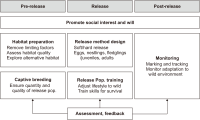
초록
Reintroduction programs have been promoted across the world to recover and rehabilitate endangered birds through ex situ captive breeding and releasing to the nature. The ultimate aims of these reintroduction programs are recovery of sustainable populations in natural habitats. To ensure the success of the reintroduction programs, it is necessary to examine the followings in order to increase the success rate of releasing along with the development of captive breeding techniques: 1) Adequate habitat provision, 2) adaptability of captive-bred individuals, 3) survivability of released individuals, and 4) social interest and will. Before releasing captive-bred individuals, it should be reviewed whether there are habitats in which the limiting factor is removed, and assessed their long-term safety. The quantity and quality of the released individuals must be considered to increase the chances for mate selection, maintain genetic diversity, and acquire the ability to adapt to the wild. The release method must be decided in consideration of characteristics of the target habitats and individuals, and rational means such as careful observation, evaluation, and feedback must be provided throughout the release process. For the long-term success of recovery projects, social awareness, sustainable support, and related experts are needed. Satisfying these criteria can help to increase the success rates of reintroduction programs. For the bird reintroduction program in the future, the feasibility of the methods and procedures must be closely reviewed before starting.
Abstract
Reintroduction programs have been promoted across the world to recover and rehabilitate endangered birds through ex situ captive breeding and releasing to the nature. The ultimate aims of these reintroduction programs are recovery of sustainable populations in natural habitats. To ensure the success of the reintroduction programs, it is necessary to examine the followings in order to increase the success rate of releasing along with the development of captive breeding techniques: 1) Adequate habitat provision, 2) adaptability of captive-bred individuals, 3) survivability of released individuals, and 4) social interest and will. Before releasing captive-bred individuals, it should be reviewed whether there are habitats in which the limiting factor is removed, and assessed their long-term safety. The quantity and quality of the released individuals must be considered to increase the chances for mate selection, maintain genetic diversity, and acquire the ability to adapt to the wild. The release method must be decided in consideration of characteristics of the target habitats and individuals, and rational means such as careful observation, evaluation, and feedback must be provided throughout the release process. For the long-term success of recovery projects, social awareness, sustainable support, and related experts are needed. Satisfying these criteria can help to increase the success rates of reintroduction programs. For the bird reintroduction program in the future, the feasibility of the methods and procedures must be closely reviewed before starting.

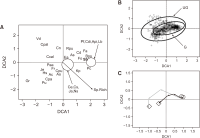
초록
Saxifraga hirculus is classified as a vulnerable plant species in Europe, and it is confined to base-rich flushes in the British uplands. However, a lack of available information about its conservation status hampers the development of adaptive strategies for its in-situ conservation, especially with respect to grazing. To assess the effectiveness of sheep grazing in maintaining viable populations of S. hirculus, we compared the community dynamics of the vegetation in a base-rich flush over 44 years in two plots: one sheep-grazed under business-as-usual sheep grazing densities and the other fenced to exclude grazing. The plots were established in 1972, and the abundances of all vascular plants, bryophytes, and litter were measured at six intervals until 2016. Our results showed that although the presence of S. hirculus was maintained in both plots over the 44 years, it declined and reached a minimum between 1995 and 2010, when it was close to extinction. Since 2013, Saxifraga has recovered only slightly. Interestingly, the S. hirculus response appeared to be independent of grazing treatment, but it mirrored wider changes in the vegetation composition and structure within the flush over the 44 years. These changes are similar to others reported in broader uplands that have been attributed to a combination of reduced nitrogen and sulfur deposition and global warming. Thus, the simple adaptive management approach of “just managing” sheep grazing appeared ineffectual for preserving the S. hirculus population. S. hirculus showed signs of recovery at the end of the study period within this base-rich flush.
Abstract
Saxifraga hirculus is classified as a vulnerable plant species in Europe, and it is confined to base-rich flushes in the British uplands. However, a lack of available information about its conservation status hampers the development of adaptive strategies for its in-situ conservation, especially with respect to grazing. To assess the effectiveness of sheep grazing in maintaining viable populations of S. hirculus, we compared the community dynamics of the vegetation in a base-rich flush over 44 years in two plots: one sheep-grazed under business-as-usual sheep grazing densities and the other fenced to exclude grazing. The plots were established in 1972, and the abundances of all vascular plants, bryophytes, and litter were measured at six intervals until 2016. Our results showed that although the presence of S. hirculus was maintained in both plots over the 44 years, it declined and reached a minimum between 1995 and 2010, when it was close to extinction. Since 2013, Saxifraga has recovered only slightly. Interestingly, the S. hirculus response appeared to be independent of grazing treatment, but it mirrored wider changes in the vegetation composition and structure within the flush over the 44 years. These changes are similar to others reported in broader uplands that have been attributed to a combination of reduced nitrogen and sulfur deposition and global warming. Thus, the simple adaptive management approach of “just managing” sheep grazing appeared ineffectual for preserving the S. hirculus population. S. hirculus showed signs of recovery at the end of the study period within this base-rich flush.


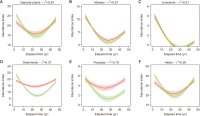

초록
The degree distribution of the plant-pollinator network was identified by analyzing the data in the ecosystem and reproduced by a model of the growing bipartite mutualistic networks. The degree distribution of pollinator shows power law or stretched exponential distribution, while plant usually shows stretched exponential distribution. In the growth model, the plant and the pollinator are selected with probability Pp and PA=1–Pp, respectively. The number of incoming links for the plant and the pollinator is lp and lA, respectively. The probability that the link of the plant selects the pollinator of the existing network given as Aki =kλiA/∑ikλiA , and the probability that the pollinator selects the plant is Pki=kλip/∑ikλip. When the nonlinear growth index is λχ=1 (Χ=A or P), the degree distribution follows a power law, and if 0≤λχ<1, the degree distribution follows a stretched exponential distribution. The cumulative degree distributions of plants and pollinators of 14 empirical plant-pollinators included in Interaction Web Database were calculated. A set of parameters (PA,PP,lA,lP) that reproduces these cumulative degree distributions and a growth index λχ=1 (Χ=A or P) were obtained. We found that animal takes very heterogenous connections, whereas plant takes a more flexible connection network.
Abstract
The degree distribution of the plant-pollinator network was identified by analyzing the data in the ecosystem and reproduced by a model of the growing bipartite mutualistic networks. The degree distribution of pollinator shows power law or stretched exponential distribution, while plant usually shows stretched exponential distribution. In the growth model, the plant and the pollinator are selected with probability Pp and PA=1–Pp, respectively. The number of incoming links for the plant and the pollinator is lp and lA, respectively. The probability that the link of the plant selects the pollinator of the existing network given as Aki =kλiA/∑ikλiA , and the probability that the pollinator selects the plant is Pki=kλip/∑ikλip. When the nonlinear growth index is λχ=1 (Χ=A or P), the degree distribution follows a power law, and if 0≤λχ<1, the degree distribution follows a stretched exponential distribution. The cumulative degree distributions of plants and pollinators of 14 empirical plant-pollinators included in Interaction Web Database were calculated. A set of parameters (PA,PP,lA,lP) that reproduces these cumulative degree distributions and a growth index λχ=1 (Χ=A or P) were obtained. We found that animal takes very heterogenous connections, whereas plant takes a more flexible connection network.

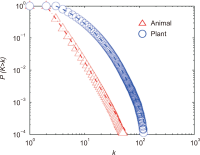
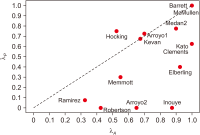
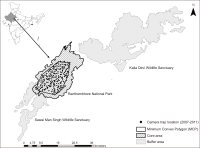
초록
Understanding temporal variations in wildlife populations is a prerequisite for conservation planning of wide-ranging species such as tigers (Panthera tigris). We determined the temporal variation in abundance, population growth, and sex ratios at different age and sex stages for a tiger population in Ranthambhore Tiger Reserve, India from November 2007 to February 2011 using motion-sensing cameras. We identified 19 male and 21 female tigers from stripe patterns during 16,110 trap nights within an area covering 233 km2. The annual abundance of the population varied from 34.9 (mean)±3.8 (SE) to 23.9±1.5, with a declining trend in the mean annual change of abundance (−12%). The density of adult females remained stable across the study duration, but the densities of adult males and non- breeding tigers fluctuated. The sex ratio was female-biased (0.58 males/female) for breeding tigers and male-biased (1.74 males/female) for non-breeding tigers. Our results reinforce the importance of long-term studies for monitoring the naturally occurring processes in populations to develop population indicators and identify reliable baseline information for conservation and management planning of populations.
Abstract
Understanding temporal variations in wildlife populations is a prerequisite for conservation planning of wide-ranging species such as tigers (Panthera tigris). We determined the temporal variation in abundance, population growth, and sex ratios at different age and sex stages for a tiger population in Ranthambhore Tiger Reserve, India from November 2007 to February 2011 using motion-sensing cameras. We identified 19 male and 21 female tigers from stripe patterns during 16,110 trap nights within an area covering 233 km2. The annual abundance of the population varied from 34.9 (mean)±3.8 (SE) to 23.9±1.5, with a declining trend in the mean annual change of abundance (−12%). The density of adult females remained stable across the study duration, but the densities of adult males and non- breeding tigers fluctuated. The sex ratio was female-biased (0.58 males/female) for breeding tigers and male-biased (1.74 males/female) for non-breeding tigers. Our results reinforce the importance of long-term studies for monitoring the naturally occurring processes in populations to develop population indicators and identify reliable baseline information for conservation and management planning of populations.

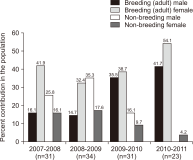

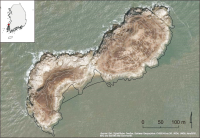
초록
The Chinese crested tern (Thalasseus bersteini) is one of the most globally endangered species, listed as “Critically Endangered (CE)” on the IUCN Red List, with only approximately 30-49 individuals surviving in the wild. Chinese crested terns were discovered to breed in South Korea for the first time in 2016 while conducting a census on uninhabited islands. The Ministry of Environment has declared the breeding habitat of the Chinese crested terns as “Specified Island” to protect this CE species. However, brown rats (Rattus norvegicus) inhabiting the breeding grounds of the Chinese crested terns and Black-tailed gulls may potentially pose a threat to the breeding of these avian species. Therefore, we conducted a study on the feeding behavior of brown rats involving stable isotope analysis to determine their food sources. Fecal analysis showed that brown rats mainly fed on plants, whereas they scarcely fed on animals, such as insects. In addition, the stable isotope analysis showed that the δ13C values of brown rats, insects, and Indian goosegrasses were approximately –16 to –11‰, whereas the δ13C value of Chinese crested terns that obtained their food from the marine ecosystem was approximately –22 to –18‰. Hence, we conclude that the source of carbon for brown rats on this island is the terrestrial ecosystem. We ruled out the possibility of any direct prey– predator interaction between the brown rat and the Chinese crested tern or Black-tailed gull.
Abstract
The Chinese crested tern (Thalasseus bersteini) is one of the most globally endangered species, listed as “Critically Endangered (CE)” on the IUCN Red List, with only approximately 30-49 individuals surviving in the wild. Chinese crested terns were discovered to breed in South Korea for the first time in 2016 while conducting a census on uninhabited islands. The Ministry of Environment has declared the breeding habitat of the Chinese crested terns as “Specified Island” to protect this CE species. However, brown rats (Rattus norvegicus) inhabiting the breeding grounds of the Chinese crested terns and Black-tailed gulls may potentially pose a threat to the breeding of these avian species. Therefore, we conducted a study on the feeding behavior of brown rats involving stable isotope analysis to determine their food sources. Fecal analysis showed that brown rats mainly fed on plants, whereas they scarcely fed on animals, such as insects. In addition, the stable isotope analysis showed that the δ13C values of brown rats, insects, and Indian goosegrasses were approximately –16 to –11‰, whereas the δ13C value of Chinese crested terns that obtained their food from the marine ecosystem was approximately –22 to –18‰. Hence, we conclude that the source of carbon for brown rats on this island is the terrestrial ecosystem. We ruled out the possibility of any direct prey– predator interaction between the brown rat and the Chinese crested tern or Black-tailed gull.



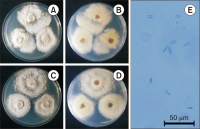
초록
Two unrecorded fungi, Diaporthe perseae and Fusarium falciforme, were isolated from soil sampled from Dokdo in Korea. There have been many reports of Diaporthe sp. and Fusarium sp. in mainland Korea but none of them have reported in Dokdo so far. We used the morphological features and two molecular markers including the internal transcribed spacer and translation elongation factor 1-α region to compare and analyze these species with the closely related taxa. As a result, we confirmed that these fungi were unrecorded soil fungi in Korea. Then, the cultural and morphological characteristics such as the conidia of these two fungal species could be clarified. These results are expected to help us to understand the distribution of fungi in Dokdo and manage the Dokdo Island Natural Reserve.
Abstract
Two unrecorded fungi, Diaporthe perseae and Fusarium falciforme, were isolated from soil sampled from Dokdo in Korea. There have been many reports of Diaporthe sp. and Fusarium sp. in mainland Korea but none of them have reported in Dokdo so far. We used the morphological features and two molecular markers including the internal transcribed spacer and translation elongation factor 1-α region to compare and analyze these species with the closely related taxa. As a result, we confirmed that these fungi were unrecorded soil fungi in Korea. Then, the cultural and morphological characteristics such as the conidia of these two fungal species could be clarified. These results are expected to help us to understand the distribution of fungi in Dokdo and manage the Dokdo Island Natural Reserve.

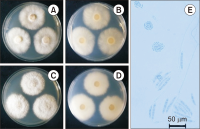



초록
In order to support biomimicry technology development, it is necessary to develop an omnidirectional service platform which can recommend principles of biomimicry and business ideas, providing experts’ networks and carrying out their relevant education and promotion on the ground of baseline data and application research materials related to biomimicry. This study was conducted to establish any probable plans for construction and utilization of the future open-platform which will collect and serve the technology of biomimicry. Accordingly, biological and ecological information databases were examined along with the appreciation of construction and management of major biomimicry DB, and, based on the materials from the interview of related experts, a customer journey map was schematized. Lastly, in order to suggest a mid-to-long-term target-model, the roles of a future biomimicry knowledge service-platform were determined along with the potential plans for its construction and management based on case analysis and customers’ needs.
Abstract
In order to support biomimicry technology development, it is necessary to develop an omnidirectional service platform which can recommend principles of biomimicry and business ideas, providing experts’ networks and carrying out their relevant education and promotion on the ground of baseline data and application research materials related to biomimicry. This study was conducted to establish any probable plans for construction and utilization of the future open-platform which will collect and serve the technology of biomimicry. Accordingly, biological and ecological information databases were examined along with the appreciation of construction and management of major biomimicry DB, and, based on the materials from the interview of related experts, a customer journey map was schematized. Lastly, in order to suggest a mid-to-long-term target-model, the roles of a future biomimicry knowledge service-platform were determined along with the potential plans for its construction and management based on case analysis and customers’ needs.



초록
Nationalism can solidify national unity and ideology but sometimes causes conflicts in human societies. Interestingly, it affects tiger conservation as well. Collaborative efforts are imperative for tiger conservation due to their vast home ranges which cross political boundaries and the limited financial resources. However, tiger states have not shown substantial commitment to collaboration. The nationalism that is entrenched in tiger conservation provides a credible explanation for this passive collaboration among nations. One type of nationalism occurs within a country by favoring one particular subspecies over another. The other type of nationalism occurs when former range countries want tigers. Instead of contributing to saving tigers in current habitats, they are eager to bring tigers back to their political boundaries regardless of the tremendous financial resources required and the lower chance of success. Considering nationalism in tiger conservation, tigers, just like humans, may need a passport for a better chance to survive.
Abstract
Nationalism can solidify national unity and ideology but sometimes causes conflicts in human societies. Interestingly, it affects tiger conservation as well. Collaborative efforts are imperative for tiger conservation due to their vast home ranges which cross political boundaries and the limited financial resources. However, tiger states have not shown substantial commitment to collaboration. The nationalism that is entrenched in tiger conservation provides a credible explanation for this passive collaboration among nations. One type of nationalism occurs within a country by favoring one particular subspecies over another. The other type of nationalism occurs when former range countries want tigers. Instead of contributing to saving tigers in current habitats, they are eager to bring tigers back to their political boundaries regardless of the tremendous financial resources required and the lower chance of success. Considering nationalism in tiger conservation, tigers, just like humans, may need a passport for a better chance to survive.
_학술지_디자인_시안_koar_top_300x55.png)
